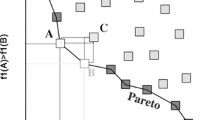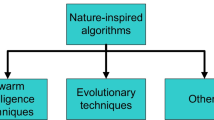Abstract
This paper addresses multi-objective optimization and the truss optimization problem employing a novel meta-heuristic that is based on the real-world water cycle behavior in rivers, rainfalls, streams, etc. This meta-heuristic is called multi-objective water cycle algorithm (MOWCA) which is receiving great attention from researchers due to the good performance in handling optimization problems in different fields. Additionally, the hyperbolic spiral movement is integrated into the basic MOWCA to guide the agents throughout the search space. Consequently, under this hyperbolic spiral movement, the exploitation ability of the proposed MOSWCA is promoted. To assess the robustness and coherence of the MOSWCA, the performance of the proposed MOSWCA is analysed on some multi-objective optimisation benchmark functions; and three truss structure optimization problems. The results obtained by the MOSWCA of all test problems were compared with various multi-objective meta-heuristic algorithms reported in the literature. From the empirical results, it is evident that the suggested approach reaches an excellent performance when solving multi-objective optimization and the truss optimization problems.







Similar content being viewed by others
References
Mirjalili S, Jangir P, Saremi S (2017) Multi-objective ant lion optimizer: a multi-objective optimization algorithm for solving engineering problems. Appl Intell 46:7995
Unal AN, Kayakutlu G (2020) Multi-objective particle swarm optimization with random immigrants. Complex Intell Syst. https://doi.org/10.1007/s40747-020-00159-y
Kaveh LK (2011) A hybrid multi-objective optimization and decision making procedure for optimal design of truss structures. IJST Trans Civ Eng 35:137–154
Gholizadeh S, Asadi H, Baghchevan A (2014) Optimal design of truss structures by improved multi-objective firefly and bat algorithms. Int J Optim Civil Eng 4(3):415–431
Deb K (2001) Multi-objective optimization using evolutionary algorithms. Wiley, Dordrecht
Cac C, Lamont GB, DA VV (2007) Evolutionary algorithms for solving multi-objective problems. Springer, New York
Yagyasen D, Darbari M, Shukla PK, Singh VK (2013) Diversity and convergence issues in evolutionary multiobjective optimization: application to agriculture science. IERI Proced 5:8186
Bosman PAN, Thierens D (2003) The balance between proximity and diversity in multi-objective evolutionary algorithms. IEEE Trans Evol Comput 7:174188
Jiang S, Yang S (2016) Convergence versus diversity in multiobjective optimization. In: International conference on parallel problem solving from Nature, Cham, p 984993
Ngatchou P, Zarei A, El-Sharkawi A (2005) Pareto multi objective optimization. In: Proceedings of the 13th international conference on intelligent systems application to power systems, IEEE, p 8491
Hua Y, Jin Y, Hao K et al (2020) Generating multiple reference vectors for a class of many-objective optimization problems with degenerate pareto fronts. Complex Intell Syst 6:275285
Srinivas N, Deb K (1994) Muiltiobjective optimization using nondominated sorting in genetic algorithms. Evol Comput 2:221–248
Deb K, Pratap A, Agarwal S, Meyarivan T (2002) A fast and elitist multiobjective genetic algorithm: NSGA-II. IEEE Trans Evol Comput 6:182–197
Coello CAC, Pulido GT, Lechuga MS (2004) Handling multiple objectives with particle swarm optimization. IEEE Trans Evol Comput 8:256–279
Knowles JD, Corne DW (2000) Approximating the non-dominated front using the Pareto archived evolution strategy. Evol Comput 8:149172
Mohamed F, Santawy E, Ahmed AN (2012) A multi-objective chaotic harmony search technique for structural optimization. Comput Sci 1:9–127
Zhang Q, Li H (2007) Moea/d: a multiobjective evolutionary algorithm based on decomposition. IEEE Trans Evol Comput 11:712–731
Sadollah A, Eskandar H, Bahreininejad A et al (2015) Water cycle algorithm for solving multi-objective optimization problems. Soft Comput 19:25872603
Guo X, Cheng GD (2004) Epsilon-continuation approach for truss topology optimization. Acta Mech Sin 20:526533
Zhang WH, Dai GM, Wang FW, Sun SP, Bassir H (2007) Using strain energy-based prediction of effective elastic properties in topology optimization of material microstructures. Acta Mech Sin 2:7789
Sui YK, Du JZ, Guo YQ (2006) Independent continuous mapping for topological optimization of frame structures. Acta Mech Sin 22:611619
Gholizadeh S, Hassanzadeh A, Milany A, Ghatte HF (2020) On the seismic collapse capacity of optimally designed steel braced frames. Eng Comput. https://doi.org/10.1007/s00366-020-01096-7
Chadchotsak P (2005) Analysis of roof truss using Timoshenko beam model. KKU Eng J 82:32–40
Noiluplao N, Bureerat S (2013) Simultaneous topology shape and sizing optimisation of plane trusses with adaptive ground finite element using moeas. Hindawi Publishing Corporation Mathematical Problems in Engineering pp 1–9
Pholdee N, Bureerat S (2012) Performance enhancement of multi-objective evolutionary optimisers for truss design using an approximate gradient. Comput Struct 106:115–124
Greiner D, Hajela P (2012) Truss topology optimization for mass and reliability considerations-co-evolutionary multi-objective formulations. Struct Multidisc Optim 45:589–613
Techasen T, Wansasueb K, Panagant N et al (2019) Simultaneous topology, shape, and size optimization of trusses taking account of uncertainties using multi-objective evolutionary algorithms. Eng Comput 35:721740
Ho-Huu V, Duong-Gia D, Vo-Duy T et al (2018) An efficient combination of multi-objective evolutionary optimization and reliability analysis for reliability-based design optimization of truss structures. Expert Syst Appl 102(262):272
Gholizadeh S, Fattahi F (2019) Multi objective design optimization of steel moment frames considering seismic collapse safety. Eng Comput. https://doi.org/10.1007/s00366-019-00886-y
Gholizadeh S, Danesh M, Gheyratmand C (2020) A new Newton metaheuristic algorithm for discrete performance-based design optimization of steel moment frames. Comput Struct 234:106–250
Bigham A, Gholizadeh S (2020) Topology optimization of nonlinear single-layer domes by an improved electro-search algorithm and its performance analysis using statistical tests. Struct Multidiscip Optim 62:18211848
Eskandar H, Sadollah A, Bahreininejad A, Hamdi M (2012) Water cycle algorithm a novel metaheuristic optimization method for solving constrained engineering optimization problems. Comput Struct 111:151–166
Sadollah A, Eskandar H, Bahreininejad A, Kim JH (2015) Water cycle algorithm with evaporation rate for solving constrained and unconstrained optimization problems. Appl Soft Comput 30:58–71
Sadollah A, Eskandar H, Bahreininejad A, Kim JH (2015) Water cycle, mine blast and improved mine blast algorithms for discrete sizing optimization of truss structures. Comput Struct 149:1–16
Deb K, Thiele L, Laumanns M, Zitzler E (2005) Scalable test problems for evolutionary multiobjective optimization. Evolutionary multiobjective optimization, advanced information and knowledge processing. Springer, London, p 105145
Zitzler E, Deb K, Thiele L (2000) Comparison of multiobjective evolutionary algorithms: empirical results. Evol Comput 8:173–195
Veldhuizen DAV, Lamont GB (1998) Multiobjective evolutionary algorithm research: a history and analysis. Citeseer 1998
Sierra MR, Coello CAC (2005) Improving PSO-based multi-objective optimization using crowding, mutation and -dominance. In: Third international conference on evolutionary multi-criterion optimization, Guanajuato, p 505519
Coello CAC, Reyes SM (2004) A study of the parallelization of a coevolutionary multiobjective evolutionary algorithm. In: MICAI (2004) Advances in artificial intelligence. Springer, Berlin, p 688697
Mirjalili S, Jangir P, Mirjalili SZ, Saremi S, Trivedi IN (2017) Optimization of problems with multiple objectives using the multi-verse optimization algorithm. Knowl Based Syst. https://doi.org/10.1016/j.knosys.2017.07.018
Siddiqi FA, Rahman M (2020) Chowdhury evolutionary multi-objective whale optimization algorithm, intelligent systems design and applications. Springer, New York, pp 431–446
Mirjalili S (2016) Dragonfly algorithm: a new meta-heuristic optimization technique for solving single-objective, discrete and multi-objective problems. Neural Comput Appl 27:10531073
Author information
Authors and Affiliations
Corresponding author
Additional information
Publisher's Note
Springer Nature remains neutral with regard to jurisdictional claims in published maps and institutional affiliations.
Rights and permissions
About this article
Cite this article
Eid, H.F., Garcia-Hernandez, L. & Abraham, A. Spiral water cycle algorithm for solving multi-objective optimization and truss optimization problems. Engineering with Computers 38 (Suppl 2), 963–973 (2022). https://doi.org/10.1007/s00366-020-01237-y
Received:
Accepted:
Published:
Issue Date:
DOI: https://doi.org/10.1007/s00366-020-01237-y




